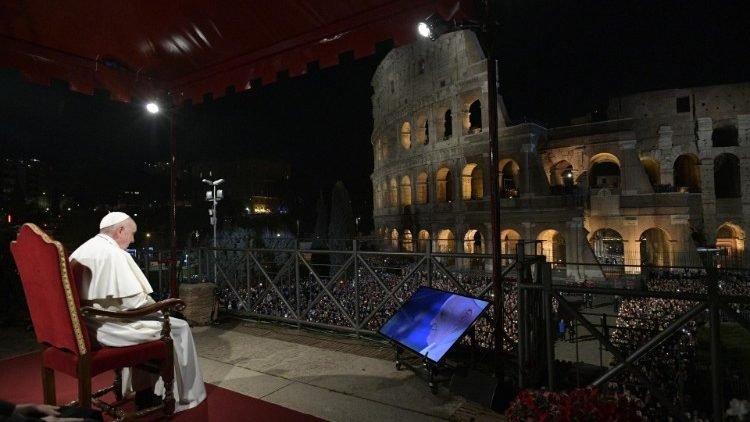Pope Francis leads the Way of the Cross against the iconic backdrop of Rome’s Colosseum on Good Friday evening, and reflects on meditations that show how Christ continues to suffer in the world today.
By Vatican News
The Via Crucis is a devotion that has been practiced by the Christian faithful for centuries. The tradition of celebrating the Way of the Cross at Rome’s Colosseum dates back to Pope Benedict XIV in the 18th century. It was Pope St Paul VI who revived the practice in 1964.
Every year a different person is chosen to prepare the texts that accompany a brief reflection at each of the 14 Stations. Pope St John Paul II wrote them himself for the Jubilee Year 2000, and then-Cardinal Joseph Ratzinger did the same in 2005.
New forms of crucifixion
This year, Pope Francis asked a woman religious to prepare the meditations. She is Sr Eugenia Bonetti, a Consolata Missionary and President of the Association “Slaves no more”, well known for her work in fighting against human trafficking. In fact, Sr Bonetti’s reflections make a point of highlighting the plight of those who suffer new forms of crucifixion in society today.
The cry of the poor
The First Station invites us to pray for those in positions of power to hear the cry of the poor, the homeless, young people, migrants, and children. No longer capable of seeing those who are in need, we ask God to help us to love, to be sensitive to tears, suffering and to the cry of pain of others.
The victims of trafficking
In this year’s meditations for the Way of the Cross, we are challenged to recognize the children who are exploited on land and sea, bought and sold for their bodies by human traffickers. When it comes to human trafficking, Sr Eugenia Bonetti writes that we need to acknowledge how we are all responsible for the problem, and how we must all be part of the solution.
The throwaway culture
In the Ninth Station, when Jesus falls the third time, exhausted and humiliated under the weight of His cross, we share the humiliation of the many young girls forced onto the streets by slave traffickers. They are the fruit of a throwaway culture that objectifies people and treats them as waste.
The idols of power and money
The image of Jesus stripped of His garments can be compared to all the children and young people who are stripped of their dignity, reduced to being merchandise, bought and sold. Sr Bonetti’s Via Crucis reflections invite us to think about the timeless idols of power and money, and how they trick us into believing everything is buyable.
The hope of His death and resurrection
The Final Station sees Jesus placed in the tomb. This image evokes the specter of today’s “new cemeteries”: the deserts and seas, where men, women, and children we could not, or would not, save, find their eternal resting place.
The meditations for this year’s Way of the Cross conclude with the hope that Jesus’ death may give world leaders an awareness of their role in defending every human person. May His resurrection be a beacon of hope, joy, new life, acceptance and communion between all peoples and all religions.



